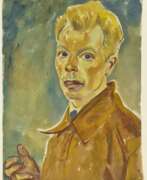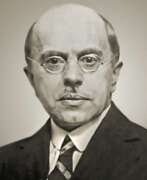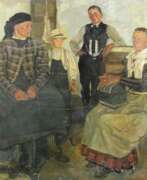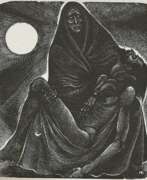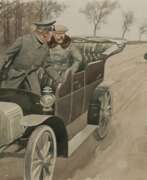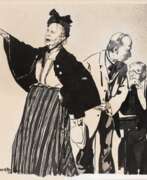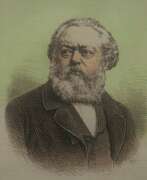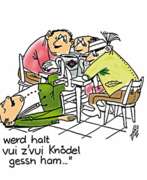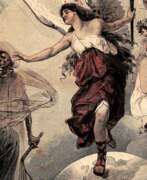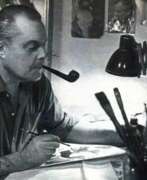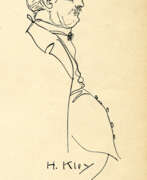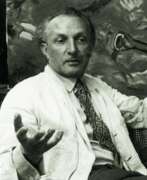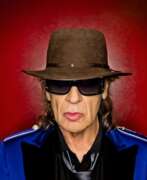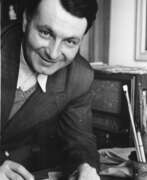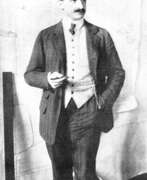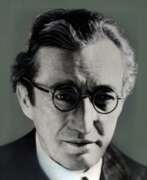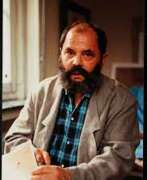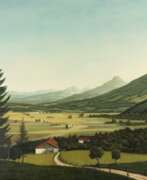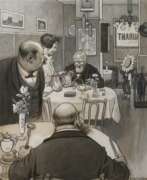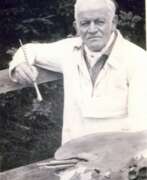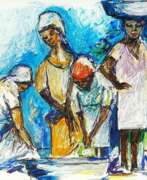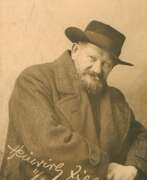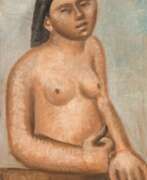Cartoonists Germany
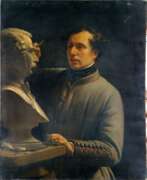

Jean-Pierre Dantan the Younger was a French caricaturist sculptor; younger brother of the academic sculptor Antoine Dantan. He studied at the Paris Academy of Arts and under François Joseph Bosio. His specialty was portrait busts, in which he conveyed the external features and character of his models with amazing fidelity.
Jean-Pierre Dantantant showed a rare ability in his work to notice the comic features of their faces and reproduce them with equanimity and a sense of proportion without offending the self-esteem of the originals who posed before him.


Alois Erbach was a German graphic artist and painter.
In his painterly works, Erbach was initially oriented towards Expressionism. Later works show influences of Surrealism and New Objectivity.
Erbach was at least close to the KPD and was a member of the Association of Revolutionary Visual Artists ASSO, the Red Group and the group "Die Zeitgemäßen" Under the pseudonym "Aleus" or "Marc Aleus", Erbach supplied caricatures for the Rote Fahne and the satirical magazines Knüppel, Die Pleite and Eulenspiegel.
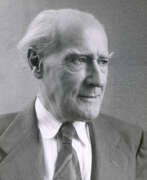

Lyonel Charles Adrian Feininger was an American-German artist renowned for his unique integration of Expressionism, Cubism, and Bauhaus principles. His body of work, which spans several critical decades in modernism's development, is celebrated for its distinctive blend of architectural and nautical motifs, articulated through planar shifts and jagged lines of Cubism, with a vibrant Orphist color palette.
Lyonel Feininger's journey as an artist began in earnest when he was 36, becoming a pivotal figure in various German expressionist groups and a founding member of the Bauhaus, where he led the printmaking workshop. His art, which also includes significant contributions to caricature and photography, explores the intricate relationship between humanity and industrialization, evident in his depictions of architectural and mechanized forms.
His work was subject to Nazi criticism, being labeled as "degenerate," which led to his return to the United States, where he continued to evolve his artistic style. Posthumously, Lyonel Feininger's art has been the focus of several retrospectives, and his pieces, like "Jesuits III," continue to fetch high figures at auctions, underscoring his lasting impact on the art world.
Notably, Lyonel Feininger's "Cathedral" woodcut, representing the Bauhaus's utopian vision, remains one of his most iconic works, symbolizing the integration of art and craftsmanship with its avant-garde yet traditional approach. His legacy is further carried by his sons, Andreas and T. Lux Feininger, who also made their marks in the arts.
For collectors and art and antiques experts, Feininger's work represents a fascinating intersection of various art movements and a testament to the enduring nature of expressive and innovative artistry. To stay updated on new product sales and auction events related to Lyonel Feininger, consider signing up for updates, ensuring you're informed about the latest opportunities to engage with his enduring legacy.
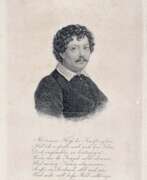

Friedrich Fleischmann was a German painter of the first third of the 19th century. He is known as a painter, graphic artist, printmaker and caricaturist.
Fleischmann studied engraving in Nuremberg and made a significant contribution to the local engraving school by introducing the technique of steel engraving. He produced some 1,900 works, including portraits of contemporaries and historical figures. Biographical sources state that the artist was banished from the city after a popular unrest caused by one of his caricatures and his house was destroyed by a mob.
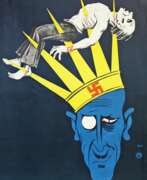

Josef Nikolaus Geis was a German graphic artist, painter, and illustrator, renowned for his contributions to the art scene in Munich. Known for his vivid posters and illustrations, Geis had a distinctive style that often captured the socio-political climate of early 20th-century Germany. His work frequently featured in Munich-based publications such as "Jugend" and "Simplicissimus," as well as the humor magazine "Fliegende Blätter."
Geis's art is not only noted for its aesthetic quality but also for its historical significance, reflecting the tumultuous times during the Weimar Republic and the early years of Nazi Germany. His posters, such as those encouraging voting for social democrats, are particularly noted for their bold colors and striking compositions. This has made his works significant both culturally and historically, finding places in art auctions and collectors' portfolios worldwide.
His legacy is preserved through collections and exhibitions in various museums, and his works continue to be discussed and sold in art circles, highlighting his lasting impact on German art history. For those interested in the intersection of art and history, Josef Geis's works offer a compelling glimpse into Germany's past through the lens of visual culture.
For collectors and art experts, staying informed about Josef Geis's artwork and related auction events can provide valuable insights into the evolution of graphic arts and its market value. If you wish to receive updates and notifications about new sales and auctions featuring Josef Geis, consider signing up for specialized newsletters.
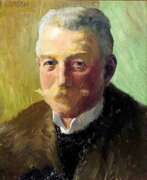

Richard Graef was a German painter, graphic artist, illustrator and cartoonist.
Graef studied painting at Hans von Hayek's school in Dachau, and then went to Paris for further studies, and afterwards opened his own studio in Dachau with his wife. Graef achieved fame as an illustrator and cartoonist, whose subjects - human vices and weaknesses, the relationship of the rich and poor and so on. He is one of the most famous and prolific cartoonists of the satirical weekly Simplicissimus and one of the oldest members of the Dachau artist colony at the time.
Graef also mastered wood engraving, but over time turned increasingly to watercolor and oil painting, creating still lifes and portraits as well as landscape paintings.
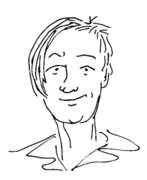

Friederike Groß is a German painter, caricaturist and university teacher who lives and works as a freelance artist in Stuttgart.
Friederike Groß studied free graphics and art education with Dieter Groß at the State Academy of Fine Arts Stuttgart from 1984 to 1989. Since 1985, Friederike Groß has worked as a caricaturist for the Stuttgarter Zeitung.
From 2008 to 2014, Friederike Groß taught as a lecturer in drawing at the Swiss Federal Institute of Technology (ETH) in Zurich. Since 2013, she has held a professorship for illustration at the Berlin Technical University of the Arts (BTK) at the campus in Hamburg.
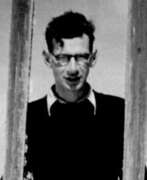

Rudolf Grossmann (German: Rudolf Grossmann, or Großmann), full name Rudolf Wilhelm Walther Grossmann, was a German painter, draftsman, illustrator and graphic artist.
Born into an artistic family, Grossmann began his education in painting and printmaking at the Düsseldorf Academy before continuing his studies in Paris with Lucien Simon and Pouleroz. Among his best-known works are various portrait drawings of celebrities, notably those published in the satirical periodical Simplicissimus; he was also known for his book illustrations. Grossmann began publishing his prints in 1905, and many major publishers in Germany and France commissioned his work. He later concentrated on figurative works and urban scenes, which showed the influence of Cézanne and Pasquin.
From 1928 until Hitler's Nazi Party came to power, Grossmann taught at the Berlin Royal School of Art and was a member of the Berlin Secession and the Deutsche Kunstlerbund. In 1934, his work, like that of many of his colleagues, was stigmatized as degenerate and confiscated by the Nazi government, and he was disbarred from practicing his profession. He soon left for Freiberg im Beisgau, where he died on November 28, 1941.
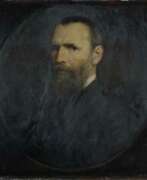

Edmund Harburger was a German artist of the last third of the nineteenth and early twentieth centuries. He is known as a painter, graphic artist, illustrator, and caricaturist.
Harburger became famous for more than 1,500 humorous drawings for the magazine Fliegende Blätter. He also created book illustrations and political cartoons. After living for two years in Venice, the artist practiced there copying the works of the old masters. His exhibitions were held in various European cities, including Paris, Berlin and Munich. His works are kept in museums in various countries, including the New Pinakothek in Munich and museums in Gdansk, Leipzig, Prague and other cities.
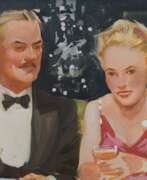

Kurt Heiligenstaedt, born on 13 August 1890 in Roßleben, Germany, was a distinguished artist known for his contributions as a poster designer, commercial graphic artist, and caricaturist. He is particularly recognized for his work with the German magazine "Simplicissimus," where he regularly contributed his drawings starting from 1923/1924 and then more consistently from 1935 onwards. In total, "Simplicissimus" published 428 of his drawings, highlighting his prolific output and significant role in the magazine.
Heiligenstaedt specialized in naturalistic yet elegantly drawn erotic scenes in contemporary costumes, which were among the first Pin-up images in Germany. His work for the successor magazine to "Simplicissimus" in 1959 was notable for causing a rare seizure action at the time due to the depiction of suggested nipples on a cover image.
He passed away in 1964 at the age of 73 in Berlin and was buried at the Waldfriedhof Zehlendorf, although his grave is no longer preserved. Heiligenstaedt's artistic style and his contributions to graphic design and caricature make him a notable figure in the history of German art.
Kurt Heiligenstaedt's work remains relevant for collectors, auctioneers, and experts in art and antiques, reflecting a unique blend of commercial artistry and illustrative skill. His legacy continues to inspire contemporary artists and designers.
For those interested in staying updated on events and sales related to Kurt Heiligenstaedt’s works, signing up for relevant newsletters and updates would be beneficial. This ensures staying informed about new discoveries and opportunities related to his art.
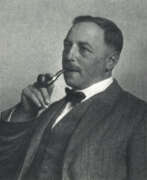

Thomas Theodor Heine was a German-Swedish artist of late nineteenth and early twentieth centuries of Jewish origin. He is known as a painter, draftsman, illustrator and writer.
Heine co-founded the popular German satirical weekly Simplicissimus, where he printed his drawings and caricatures. He also collaborated with the magazines Flying Pages and Youth, illustrated books, and created advertising posters and erotic drawings. After the Nazis came to power, the artist fled to Sweden, where he obtained citizenship. His works were presented at a retrospective anniversary exhibition in Stockholm in 1947, a year before Heine's death.
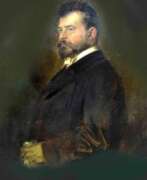

Adolf Hengeler was a German artist and illustrator, renowned for his distinctive style that beautifully merged humor with meticulous detail. Born on February 11, 1863, in Kempten, Allgäu, Hengeler's journey in the arts led him to Munich, where he left an indelible mark on the art and culture of the era.
Hengeler's body of work is diverse, encompassing applied graphics, caricatures, and picture stories. His graphic work, ranging from airy color drawings to precise ink strokes, has often been compared to Wilhelm Busch for its unique charm and precision. Notably, Hengeler regularly contributed to the "Fliegende Blätter" and created popular publications like the "Münchner Kinderfibel" and the "Kriegstagebuch 1914/15".
In painting, Hengeler focused on landscapes, often featuring cherubs and mythical creatures, and idyllic scenes of people in landscapes. His paintings are characterized by earthy brown tones, highlighted by bright local and pastel tones in flesh, clothing, or flowers, capturing the beauty of nature in Oberbayern and Allgäu. In his later years, Hengeler turned to Christian legends and biblical figures, adding a spiritual dimension to his natural scenes.
Hengeler's legacy is preserved in the Museum der Stadt Kempten, as per the bequest of his grandson, the art historian Peter von Bomhard. The museum houses Hengeler's personal and artistic belongings, including furniture and portraits, in a dedicated Hengeler Room.
For collectors, auctioneers, and experts in art and antiques, Adolf Hengeler's work offers a unique window into the culture and art of his time. His contributions to the German art scene, especially through his distinctive style and thematic diversity, make his works highly valued and sought after.
For those interested in staying updated on new product sales and auction events related to Adolf Hengeler's works, we invite you to sign up for our updates. This subscription is tailored specifically to keep you informed about relevant events and opportunities in the world of Adolf Hengeler's art.


Dieter Huthmacher, born in 1947 in Pforzheim, Germany, is a renowned artist celebrated for his contributions to the world of fine art. His creative journey is marked by a diverse array of print graphics, where he skillfully blends color and form to create captivating works. Huthmacher's art is not only a reflection of his mastery in various techniques but also a testament to his deep understanding of artistic expression.
Throughout his career, Huthmacher has explored different themes and motifs, often experimenting with large formats and various color techniques. His works, primarily consisting of prints, have been featured in several auctions, indicating the consistent interest and value placed on his art in the collectors' market. Notable pieces like "Thalia," created around 1988, showcase his proficiency in color woodcut techniques and are representative of his artistic signature.
Dieter Huthmacher's works continue to be sought after, with auctions featuring over 25 graphic prints of various motifs, demonstrating his versatility and appeal in the art world. His creations have been presented in prestigious auction houses, resonating with collectors, auctioneers, and art enthusiasts alike.
For those interested in the world of art and antiques, particularly in the works of Dieter Huthmacher, staying informed about upcoming auctions and sales can be incredibly beneficial. By signing up for updates, you can receive timely information about new product sales and auction events related to Dieter Huthmacher's art, ensuring you never miss an opportunity to acquire a piece of his esteemed collection.
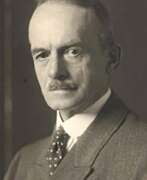

Angelo Jank was a German animal painter, illustrator and member of the Munich Secession. He was the son of the German painter Christian Jank and specialized in scenes with horses and riders. For many years, he was also employed as an illustrator for the magazines Jugend and Simplicissimus, And he was also an instructor at the Academy of Fine Arts. In addition to his canvases, he painted murals at the Justizpalast and scenes from history at the Reichstag building in Berlin. His work was also part of the painting event in the art competition at the 1936 Summer Olympics.


Jeanne Mammen was a twentieth-century German artist. She is known as a graphic artist and draftsman, a representative of modernism, a prominent figure in the artistic life of the Weimar Republic.
Jeanne Mammen developed an artistic style close to the New Materialism school. As she grew older, her work became more symbolic; after 1945, the artist moved towards abstractionism. She worked for fashion magazines, created movie posters, and illustrated erotic poetry. Mammen actively developed collage techniques, as well as creating portraits and caricatures, and sketching street types.
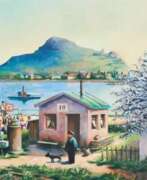

Otto Nückel was a German painter, graphic designer, illustrator and cartoonist. He is best known as one of the 20th century's pioneer wordless novelists, along with Frans Masereel and Lynd Ward. He developed his skill in drawing and painting, joining the artists' association, the Munich Sezession, and developing an interest in relief printing. Because of the scarcity of wood, Nückel made engravings for relief prints on lead plates. A pioneer in lead engraving, Nückel developed an accomplished mastery of this medium, distinguished by ample use of the multiple-line tool. Much of Nückel's work favors dark comedy, profound irony and an often scathing sarcasm.
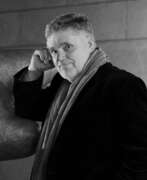

Markus Oehlen is a German artist and musician.
Markus Oehlen graduated from the Düsseldorf Academy of Fine Arts, where his mentor was Alfonso Hüppi. Oehlen was one of the main members of the German "New Wilde" (Neue Wilde) art movement, which flourished in the 1980s and was characterized by the use of punk style elements in opposition to the then prevalent minimalism.
Oelen is constantly refining the technique of his paintings and also working in parallel on sculptures and musical projects. His new works are increasingly influenced by the perceptual experiments of op-art with their interference of printed images, which emerge as lattice patterns from below and above the image layers. Alongside forms oriented towards a computer aesthetic, this brings elements of the avant-garde into his images. By rearranging the individual compositional elements of the canvas, Oelen creates surrealist still lifes, playing with the notion of chance and suggesting bizarre narratives.
Markus Oehlen has been a professor at the Academy of Fine Arts in Munich since 2002.
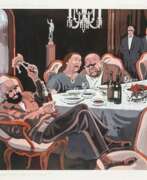

Manfred Oesterle was a German painter, graphic artist, caricaturist and sculptor. In 1948 he was able to achieve professional success in the first satirical post-war magazine "Das Waspennest", founded by Werner Finck and Thaddäus Troll. From 1952 to 1955, Oesterle worked as a caricaturist for “Nebelspalter”, Rorschach/Switzerland. From 1955 to 1967 Oesterle was a permanent employee and member of the editorial board of "Simplicissimus", Munich. With 223 covers, he was the most frequently printed cartoonist of the internationally renowned satirical magazine. For many years, his caricatures, which are outstanding in terms of craftsmanship and intellectual excellence, have also appeared in “Spiegel”, “Zeit”, “Stern”, “Quick”, “Focus”, the “Süddeutsche Zeitung”, the “Augsburger Allgemeine Zeitung”, the “ Südwestpresse” and “Unser Geld”. Oesterle impressed with its immensely broad spectrum. His keen powers of observation and his almost eidetic memory for people and situations shaped Oesterle's paintings and graphics, especially in oil paintings and portraits. Wall and ceiling paintings, glass windows and tapestries were designed and executed by him as well as sculptures, reliefs and mosaics. As a master of the line, he always looked for the characteristic in his motifs. His drawings are pointed and humorous, ironic and critical, but never offending.
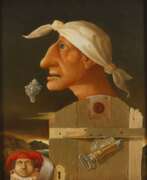

Hans Reiser is a German surrealist artist and caricaturist who lives and works in Reichersboerne.
Hans Reiser studied at the Academy of Fine Arts in Munich and has been drawing weekly cartoons for the Telzer Kurier since 1970. His work has also been published in many newspapers and magazines. Since 1979, the artist has participated in numerous exhibitions at home and abroad.
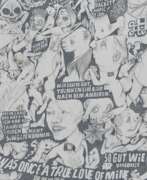

Dorothea Schulz is a German artist and graphic artist.
She reveals etymologies, finds pleasure in bar chatter and images, and discovers the Last Judgment both in pubs and in institutions of federal justice.
For about ten years now, Dorothea Schulz has been predominantly concerned with comprehension and communication, listening and its visual processing. The artist creates her so-called listening drawings during conversations that she accidentally hears or in which she herself actively participates. Snippets of speech are mixed with small, sometimes grotesque figurative drawings to create documents of spoken language that expose both the everyday use of language and its associative processing in the act of communication.
Dorothea Schulz became known to a wider audience after her participation in the exhibition Funny Cuts (2004) at the Staatsgalerie Stuttgart.


Carl Strathmann was a German painter in the Art Nouveau and Symbolist styles.
He was a member of the artists' association, Allotria and, briefly, the Munich Secession, but left after some unspecified disputes. In 1904, together with René Reinicke, Hans Beat Wieland, Rudolf Köselitz, Wilhelm Jakob Hertling, and several others, he co-founded the Munich Watercolorists' Association. He exhibited with the Deutscher Künstlerbund and the Berlin Secession, which held a major showing of his work in 1917.
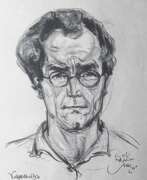

Emil Wilhelm Stumpp was a German painter, teacher, and artist known for his cartoons and drawings of well-known people in the 1930s during the Weimar Republic. He created portraits of many well known people including Bertold Brecht, Chancellor Friedrich Ebert, Thomas Mann. He was eventually commissioned to create a portrait of Adolf Hitler for his birthday in 1933. The work was not well received and the portrait, Stumpp, his paper (the General Anzeiger), and its editor were all prohibited. He left about 6,000 drawings which were all drawn from life.
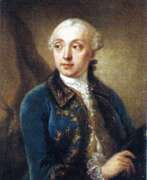

Stefano Torelli was an Italian painter, born in 1712 in Bologna. Renowned for his mastery in the Rococo style, Torelli initially trained under his father, Felice Torelli, and later under Francesco Solimena. His career flourished after being invited by Augustus III, the future King of Poland, to Dresden in 1740. There, he contributed significantly to decorating the royal palaces with altar-pieces, ceiling paintings, and collaborating with artists like Canaletto on views of Dresden.
Torelli's notable works include the "Portrait of Empress Catherine II" and the "Coronation of Catherine II", both reflecting his keen ability to blend opulence with intricate detail, a hallmark of the Rococo period. These works are celebrated for their artistic merit and are held in high esteem at institutions like The Russian Museum and The Tretyakov Gallery.
After his time in Dresden, Torelli was summoned to Russia in 1762, where he became a significant figure at the Russian court. His Russian period was marked by extensive contributions to palace decorations and portraits of royalty and nobility, enhancing his reputation and influence in the art world of his time.
For collectors and experts interested in Stefano Torelli's works, his paintings can be viewed at major museums, and reproductions are available for those wishing to own a piece inspired by his artistry. For updates on exhibitions and sales related to Stefano Torelli's works, signing up for dedicated newsletters can be a valuable resource.
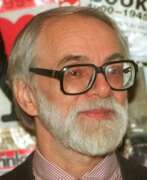

Karel Trinkewitz was a German-Czech artist, cartoonist and writer.
Karel's family was persecuted in the 1930s and 40s in Bohemia and Germany due to racial persecution, and as a half-Jew it was difficult for him to get an education at all. After World War II, Karel Trinkewitz worked in the Czech Republic for ten years as a writer, graphic artist and cartoonist, and from 1961 also as an editor of various cultural magazines. Shortly after August 21, 1968, as an active participant in the Prague Spring, he lost his job and eventually, after political unrest and relocations, had to move permanently to Germany.
In painting Trinkewitz was fascinated by the work of Salvador Dali, he also practiced calligraphic drawing and collage. In general, collage is a typical and basic creative expression for him.


Adolf Uzarski was a German writer, painter and illustrator.
Trained as an architect, Adolf also graduated from the Düsseldorf School of Arts and Crafts, and exhibited his first Art Nouveau paintings. During the First World War he painted posters and postcards with patriotic content, during these years his anti-war lithograph series "Dance of Death" was published. In 1919 Adolf Uzarski became one of the founders of the avant-garde artists' association "Young Rhineland" in Düsseldorf, he became interested in Expressionism and the current in art "New Materiality".
Uzarski always opposed militarism, nationalism and anti-Semitism, and his art was caricatured and sharply satirical of bourgeois society. With the advent of the National Socialists in Germany in 1933, Adolf Uzarski was persecuted. For many years he had to live semi-clandestinely, in 1942 the Nazis condemned him as a degenerate artist and forbade him to paint, forcing him to flee to Belgium. At the end of World War II, Uzarski returned to Düsseldorf and continued his career.
From 1919, Adolf Uzarski began writing satirical novels, publishing a total of 10 volumes, as well as children's picture books.
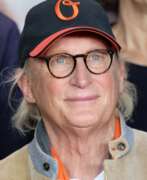

Otto Gerhard Waalkes is a German comedian, cartoonist, actor (including voice actor), musician, director and screenwriter. He has won many prizes and awards, among them the Order of Merit of the Federal Republic of Germany.
The little elephant Ottifant, which he invented, became the symbol of Otto Walkes' art and also the character for a series of comics and cartoons.
In the late 1970s and early 1980s Valckes turned his attention to comedy, appearing on stage and on television. He became known for his wry humour and his ability to create humorous characters and voices. His performances often include a mixture of stand-up comedy, skits and musical numbers.
Wallkes has also had a successful career in film and television. He has appeared in numerous German films. He also provided the voice for several animated films.
Otto Gerhard Wallkes is a well-known philanthropist, supporting various charities in Germany and around the world.
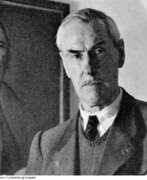

Josef Wackerle was a German sculptor. Educated in Munich, he became the artistic director of the Nymphenburg Porcelain Manufactory at a young age. Wackerle's influence extended beyond porcelain, as he contributed significantly to public art and architecture, particularly in his hometown. His works include various monuments, sculptures, and reliefs that demonstrate his commitment to integrating art within public spaces and everyday life.
Josef Wackerle's talent was recognized internationally, and his sculptures played a part in the art competitions at the 1928 and 1932 Summer Olympics. Despite the complex historical context in which he worked, including the Nazi era, Wackerle continued to receive commissions after World War II, demonstrating his art's enduring appeal. He contributed to the architectural and cultural fabric of Garmisch-Partenkirchen through numerous public artworks, including fountains, monuments, and building decorations.
For collectors and art experts, Josef Wackerle's work represents a blend of technical skill and a deep connection to Bavarian cultural identity. His contributions to porcelain art, particularly with Nymphenburg, highlight his versatility and innovation in working with various mediums.
If you're interested in staying updated on Josef Wackerle's works, particularly in the context of auctions and new discoveries, consider signing up for updates. This subscription will ensure you're informed about new sales and auction events related to Wackerle's art, providing valuable insights for collectors and enthusiasts alike.
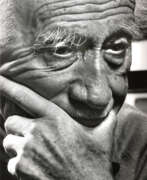

Andreas Paul Weber was a German cartoonist, engraver, and lithographer.
Weber raised the themes of medicine and the environment, but was mainly a political cartoonist, but his relationship with the Fascist regime was very complicated and ambiguous.
For example, in 1937 Weber was arrested by the Gestapo and sent to a concentration camp, but in 1940 he received the state prize for the best politically engaged artists. In the same year, he illustrated the book Soldatengeist (Soldatgeist), with a preface by Himmler himself, which sold a hundred thousand copies. In 1944, in the magazine Action. Die Aktion. Kampfblatt für das neue Europa) published a series of his drawings Leviathan against the Stalinist regime and Bolshevism.
After the war, Weber continued to produce paintings and drawings critical of the bourgeoisie and the avant-garde. Fear, death, madness and destruction remain the protagonists of his works.
During his career he created more than 200 paintings and 1500 illustrations, about 3000 lithographs.
